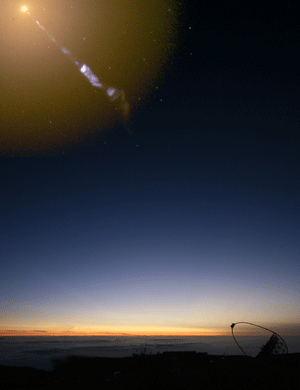Messier 87 radio galaxy particle accelerator found

03/07/2009
The results were obtained from the radio astronomical observations and very high energy gamma radiation emitted by Messier 87 in the year 2008. Daniel Mazin, IFAE researcher, and Robert Wagner, from the Max Planck Institute for Physics in Munich, both MAGIC collaboration members, worked together with researchers from the H.E.S.S. and VERITAS telescopes, and a team of radio astronomers using the Very Long Baseline Array (VLBA), to organise an unprecedented coordinated observation campaign which lasted 120 hours.
Messier 87 is a giant elliptical radio galaxy located at just 55 million light years from Earth. In its centre lies a supermassive black hole with a mass of some 6 billion times that of our Sun. The black hole emits a jet of matter in which charged particles (electrons and protons) are accelerated to near lightspeed. These acceleration processes also produce very high energy gamma rays, photons a trillion times more energetic than visible light. Gamma rays constitute the highest energy electromagnetic radiation that exist. They are produced by the most violent cosmic phenomena such as supernovas, active galactic nuclei, and what is known as "gamma ray explosions", and can be used to study extreme physical conditions which cannot be reproduced in a laboratory. Nevertheless, the exact location of gamma ray emissions in Messier 87 was unknown until now due to the limited angular resolution of gamma-ray telescopes.
At the start of 2008, the world's three best observatories in this gamma-ray energy range, MAGIC (Major Atmospheric Gamma-ray Imaging Cherenkov), VERITAS (Very Energetic Radiation Magnet Telescope Array System) and H.E.S.S. (High Energy Stereoscopic System) worked together in the observation of Messier 87 and accumulated 120 hours of data. During this observation campaign, Messier 87 experimented two episodes of rapid increase in the galaxy's emission of gamma rays. High-resolution simultaneous radio astronomic observations of the Messier 87 activities carried out by VLBA, a radiotelescopic system distributed throughout the United States, demonstrate an increase in the emission of radio waves from the most inner nucleus of the galaxy, a nucleus which is located in the immediate vicinity of the central black hole.
"Only the close collaboration of observatories capable of viewing both extremes of the electromagnetic spectrum has allowed us to identify the location of the activity registered during the episodes of gamma ray emissions and, consequently, to find the place where the Messier 87 particle accelerator is located”, explains Daniel Mazin from IFAE. The discovery, the first of its kind carried out with a galaxy, will allow researchers to learn more about how these active galactic nuclei function and which physical phenomena take place in the vicinity of black holes.
The MAGIC telescope
The telescopes MAGIC, located at the Observatory of El Roque de los Muchachos belonging to the Institute of Astrophysics of the Canary Islands (IAC), H.E..S.S. (Namibia) and VERITAS (Arizona, US), are all next generation atmospheric Cherenkov telescopes. They use large mirrors and ultrarapid cameras to detect even the briefest scintillations of blue light (Cherenkov light) produced by the cascade of subatomic particles generated when very high energy gamma rays interact with the atmosphere. A total of 400 scientists, a large part of the worldwide gamma ray astrophysics community, are taking part in these projects.
MAGIC was built and is being used by some 150 scientists from Germany, Italy, Spain, Switzerland, Poland, Finland, Croatia, Bulgaria and United States. In addition to the Institute of High-Energy Physics of Barcelona, those participating in the MAGIC telescope project include Universitat Autònoma de Barcelona, the University of Barcelona, the Institute of Space Science of Barcelona (ICE), the Institute of Astrophysics of Andalusia (IAA), the Institute of Astrophysics of the Canary Islands (IAC) and the Complutense University of Madrid.
MAGIC began working in 2004. In addition to other important results it has been used to discover the farthest source of very high energy gamma rays, located at more than 5 billion light years away, and the emission of gamma radiation from a rotating neutron star, the Crab Nebula. Recently, a second MAGIC telescope began to function which, through simultaneous operations with the first telescope, will substantially improve its sensitivity, thus permitting the detection of new less bright sources of gamma rays and the ability to carry out more detailed studies than before.
Researchers at H.E.S.S. and MAGIC are currently working together on the Cherenkov Telescope Array (CTA) project. This next generation gamma ray observatory will consist of around 100 telescopes, which represents a great improvement in sensitivity when compared to the instruments presently available.
Related links:
[1] MAGIC project website http://wwwmagic.mpp.mpg.de
Original article:
V. A. Acciari et al. "Radio imaging of the Very-High Energy Gamma-Ray Emission Region in the Central Engine of a Radio Galaxy" ScienceXpress, 2 July 2009